ColorPoetry: Multi-Sensory Experience of Color with Poetry in Visual Arts Appreciation of Persons with Visual Impairment
Abstract
1. Introduction
2. Background
2.1. Review on Ekphrasis
| (a) Artworks | |||
| Vincent van Gogh Arles, 1888 Van Gogh Museum 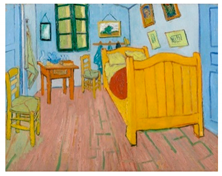 | Vincent van Gogh The Starry Night, 1889 Modern Museum of Art  | Marcel Duchamp Nude Descending a Staircase No.2, 1912 Philadelphia Museum of Art 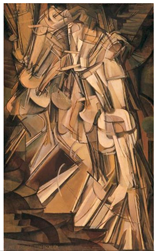 | Mark Rothko No. 13 (White, Red on Yellow), 1958 Museum of Modern Art  |
| (b) Poems | |||
| Van Gogh’s Bed Jane Flanders, 2015 [20] | The Starry Night Anne Sexton, 1961 [21] | Nude Descending a Staircase X. J. Kennedy, 1961 [22] | White, Red on Yellow Gershon Hepner, 2008 [23] |
| is orange, like Cinderella’s coach, like the sun when he looked it straight in the eye. is narrow, he sleeps alone, tossing between two pillows, while it carried him bumpily to the ball. is clumsy, but friendly. A peasant built the frame; and old wife beat the mattress till it rose like meringue. is empty, morning light pours in like wine, melody, fragrance, the memory of happiness. | The town does not exist except where one black-haired tree slips up like a drowned woman into the hot sky. The town is silent. The night boils with eleven stars. Oh starry night! This is how I want to die. It moves. They are all alive. Even the moon bulges in its orange irons to push children, like a god, from its eye. The old unseen serpent swallows up the stars. Oh starry night! This is how I want to die: into that rushing beast of the night, sucked up by that great dragon, to split from my life with no flag, no belly, no cry. |
Toe upon toe, a snowing flesh, A gold of lemon, root and rind, She sifts in sunlight down the stairs With nothing on. Nor on her mind. We spy beneath the banister A constant thresh of thigh on thigh-- Her lips imprint the swinging air That parts to let her parts go by. One-woman waterfall, she wears Her slow descent like a long cape And pausing, on the final stair Collects her motions into shape. | White and red and yellow Rothko thought more mellow than mountains that are grandiose, or portraits. Figures can be gross and mountains overwhelm the view, but colors, when they’re few and pure, achieve a balance of pure reason in every place, in every season. |
- Visual: the light blue sky
- Sound: the wind attenuating the acoustic image
- Olfactory: The smell of grass flowers
- Taste: sweet chocolate
- Tactile: warm stars
- Synesthesia: blue whistling sound
2.2. Review on Review on Color Association with Sound
2.3. Review on Color Association with Other Senses
3. Proposed ColorPoetry System
3.1. Color Selection
3.2. Algorithm of Poetry Coding Colors
| Algorithm1 ColorPoetry (i.e., Poetry Coding Colors). |
| Input: a color C in an artwork A, a poem database DP. Output: a set of poems P ∈ DP. 1: For every color in C Identify the set of poems P, finding sigmax S (A, P), for all P ∈ DP. 2: Return P. |
3.3. Overall Solution Strategy
3.4. Voice Modulation
3.5. Use Cases
| Color | Poet | Part of Poem Excerptfrom the Original Poem | Modulated Voice | |
|---|---|---|---|---|
| Word | Phrase | |||
| Cool dark blue sky and night | P1: Dark Blue Sky Peter S. Quinn [53] | Dark blue sky’s out there, Before daybreak is in; Falling stars here and there, Night and distant moon, Sleepless is my night; |  |  |
| P2: Blue on Blue Sandra Feldman [54] |
The skies so blue, The Sky, the Ocean, sadly Blue. Upon a blue-lit tingling Star, That Love can travel to the moon, And much that’s Blue is a Mirage. |  |  | |
| Light warm yellow star White star | P3: Yellow Star Vijay Sai [55] |
A yellow star In a sky Twinkling white ones It’s a yellow bird My beautiful little yellow bird! |  |  |
| Light Cool blue wind | P4: The wind has a blue tail Arjen Duinker [56] | The wind has a blue tail The wind also has a white tail |  |  |
| P5: Blue, Blue and Blue Karun Aker [57] |
Blue smells like my mother’s perfume On a windy day |  |  | |
| Warm orange moon | P6: Crushed Orange Moon Robert Murray Smith [58] |
Crushed orange moon, Hold your color for the delight of night. When you crush orange light for our sight. |  |  |
| Cool dark Green (or Cool brown) tree | P7: Beneath the Dark Green Grove Megan Cooper [59] |
I think of us beneath the trees, Beneath the dark green grove. |  |  |
| P8: Color Poems; Brown Alex Safford [60] | Brown in the color of nature itself. Brown is the color of an oakwood shelf. Brown is the trunks of the trees |  |  | |
| Cool green town | P9: Green: The Color Bri Edwards [61] | My favorite colors are green and brown. Green-leafed trees polka-dot our town. |  |  |
3.6. Implicit Association Test to Find a Solution to the Problem of ColorPoetry
4. Usability Test and Result
5. Discussion and Conclusions
Supplementary Materials
Author Contributions
Funding
Institutional Review Board Statement
Informed Consent Statement
Acknowledgments
Conflicts of Interest
References
- Calvert, G.A.; Spence, C.; Stein, B.E. The Handbook of Multisensory Processes; MIT Press: London, UK, 2004. [Google Scholar]
- Haverkamp, M. Synesthetic Design: Handbook for a Multi-Sensory Approach; Walter de Gruyter: Berlin, Germany, 2012; p. 139. [Google Scholar]
- Cottin, M.; Faria, R.; Amado, E. The Black Book of Colors; Groundwood Books Ltd.: Toronto, ON, Canada, 2008. [Google Scholar]
- Vinter, A.; Orlandi, O.; Morgan, P. Identification of Textured Tactile Pictures in Visually Impaired and Blindfolded Sighted Children. Front. Psychol. 2020, 11, 345. [Google Scholar] [CrossRef] [PubMed]
- Damásio, A. O Erro De Descartes: Emoção, Razão E O Cérebro Humano; Editora Companhia das Letras: São Paulo, Brazil, 2012. [Google Scholar]
- Damasio, A. Feeling & knowing: Making minds conscious. Cogn. Neurosci. 2020, 12, 1–2. [Google Scholar]
- Neves, J. Multi-sensory approaches to (audio) describing the visual arts. MonTI. Monogr. Traducción Interpret. 2012, 4, 277–293. [Google Scholar] [CrossRef]
- Rector, K.; Salmon, K.; Thornton, D.; Joshi, N.; Morris, M.R. Eyes-free art: Exploring proxemic audio interfaces for blind and low vision art engagement. Proc. Acm Interact. Mob. Wearable Ubiquitous Technol. 2017, 1, 1–21. [Google Scholar] [CrossRef]
- Schifferstein, H.N.J. Comparing Mental Imagery across the Sensory Modalities. Imagin. Cogn. Pers. 2009, 28, 371–388. [Google Scholar] [CrossRef]
- Literary Devices. Imagery. 2021. Available online: https://literarydevices.net/imagery/ (accessed on 29 March 2021).
- Trent, A. What Is Synesthesia in Poetry? Available online: https://penandthepad.com/synesthesia-poetry-1824.html (accessed on 29 March 2021).
- Betts, J. Synesthesia Examples in Literature and Poetry. Available online: https://examples.yourdictionary.com/synesthesia-examples-in-literature-and-poetry.html (accessed on 29 March 2021).
- Jansson, M. Ekphrasis and digital media. Poet. Today 2018, 39, 299–318. [Google Scholar] [CrossRef]
- Wagner, P. Introduction: Ekphrasis, Iconotexts, and Intermediality–the State (s) of the Art (s). In Icons-Texts-Iconotexts; de Gruyter: Berlin, Germany, 2012; pp. 1–40. [Google Scholar]
- De Armas, F.A. Visual Culture: Art and Ekphrasis in Early Modern Spain. In A Companion to the Spanish Renaissance; Brill: Leiden, The Netherlands, 2018; pp. 450–470. [Google Scholar]
- Hirsch, E. Transforming Vision: Writers on Art; Little Brown and the Art Institute of Chicago: New York, NY, USA, 1994. [Google Scholar]
- Yu, W.; Xiaojie, L. On the Expressions in Color in the Poems of William Carlos on the Expressions in Color in the Poems of William Carlos Williams. Foreign Lit. Stud. 2011, 33, 113–120. [Google Scholar]
- Koch, K. Rose, Where Did You Get That Red? Random House: New York, NY, USA, 1973. [Google Scholar]
- Routman, R. Kids’ Poems: Teaching Third and Fourth Graders to Love Writing Poetry; Scholastic: New York, NY, USA, 2000. [Google Scholar]
- Flanders, J. Van Gogh’s Bed. 2015. Available online: https://www.poemhunter.com/poem/van-gogh-s-bed/ (accessed on 4 March 2021).
- Sexton, A. “The Starry Night” from the Complete Poems of Anne Sexton; Houghton Mifflin: Boston, MA, USA, 1981; pp. 53–54. [Google Scholar]
- Kennedy, X.J. Nude Descending a Staircase; Doubleday, Incorporated: New York, NY, USA, 1961. [Google Scholar]
- Hepner, G. White, Red on Yellow. 2008. Available online: https://www.poemhunter.com/poem/white-red-on-yellow/ (accessed on 3 March 2021).
- Cho, J.D. A Study of Multi-Sensory Experience and Color Recognition in Visual Arts Appreciation of People with Visual Impairment. Electronics 2021, 10, 470. [Google Scholar] [CrossRef]
- Cho, J.D.; Quero, L.C.; Bartolomé, J.I.; Lee, D.W.; Oh, U.; Lee, I. Tactile colour pictogram to improve artwork appreciation of people with visual impairments. Color Res. Appl. 2021, 46, 103–116. [Google Scholar] [CrossRef]
- Cho, J.D.; Jeong, J.; Kim, J.H.; Lee, H. Sound Coding Color to Improve Artwork Appreciation by People with Visual Im-pairments. Electronics 2020, 9, 1981. [Google Scholar] [CrossRef]
- Iranzo Bartolomé, J.; Cho, J.D.; Cavazos Quero, L.; Jo, S.; Cho, G. Thermal Interaction for Improving Tactile Artwork Depth and Color-Depth Appreciation for Visually Impaired People. Electronics 2020, 9, 1939. [Google Scholar] [CrossRef]
- Anikin, A.; Johansson, N. Implicit associations between individual properties of color and sound. Atten. Percept. Psychophys. 2019, 81, 764–777. [Google Scholar] [CrossRef] [PubMed]
- Doppler Effect. Available online: https://science.jrank.org/pages/2147/Doppler-Effect-Doppler-effect-in-sound-waves.html#ixzz6qHpjElX0 (accessed on 29 March 2021).
- Jonas, C.; Spiller, M.J.; Hibbard, P. Summation of visual attributes in auditory–visual crossmodal correspondences. Psychon. Bull. Rev. 2017, 24, 1104–1112. [Google Scholar] [CrossRef] [PubMed]
- Cogan, R.D. Sonic Design: The Nature of Sound and Music; Prentice Hall: Upper Saddle River, NJ, USA, 1976. [Google Scholar]
- Kandinsky, V. Concerning the Spiritual in Art; Dover Publications: Mineola, NY, USA, 1977. [Google Scholar]
- Hamilton-Fletcher, G.; Witzel, C.; Reby, D.; Ward, J. Sound properties associated with equiluminant colors. Multisens. Res. 2017, 30, 337–362. [Google Scholar] [CrossRef]
- Giannakis, K. Sound Mosaics: A Graphical User Interface for Sound Synthesis Based on Audio-Visual Associations. Ph.D. Thesis, Middlesex University, London, UK, 2001. [Google Scholar]
- Marks, L.E.; Hammeal, R.J.; Bornstein, H.M. Perceiving similarity and comprehending metaphor. Monogr. Soc. Res. Child Dev. 1987, 52, 1–102. [Google Scholar] [CrossRef] [PubMed]
- Wilms, L.; Oberfeld, D. Color and emotion: Effects of hue, saturation, and brightness. Psychol. Res. 2018, 82, 896–914. [Google Scholar] [CrossRef]
- Rowe, A. Audio Dictionary: “Warm” vs. “Neutral” vs. “Bright”. Available online: https://xander51.medium.com/audio-dictionary-warm-vs-neutral-vs-bright-and-the-role-your-brain-plays-in-all-this-2ec761759f7b (accessed on 29 March 2021).
- Domino, G. Synesthesia and creativity in fine arts students: An empirical look. Creat. Res. J. 1989, 2, 17–29. [Google Scholar] [CrossRef]
- Cytowic, R.E. Synesthesia: A Union of the Senses; MIT Press: Cambridge, MA, USA, 2002. [Google Scholar]
- Cytowic, R.E. Synesthesia; MIT Press: Cambridge, MA, USA, 2018; ISBN 9780262535090. [Google Scholar]
- Maxwell, N.F. “Visualizing Sound: Effects of Pitch Height and Tonality on Luminance Matching. Inquiries J. Student Pulse 2013, 5(10). Available online: http://www.inquiriesjournal.com/a?id=767 (accessed on 28 April 2021).
- Goller, A.I.; Otten, L.J.; Ward, J. Seeing sounds and hearing colors: An event-related potential study of auditory-visual syn-esthesia. J. Cogn. Neurosci. 2009, 21, 1869–1881. [Google Scholar] [CrossRef] [PubMed]
- Niccolai, V.; Jennes, J.; Stoerig, P.; Van Leeuwen, T.M. Modality and variability of synesthetic experience. Am. J. Psychol. 2012, 125, 81–94. [Google Scholar] [CrossRef]
- Brigg, D. The Dimension of Color. Available online: http://www.huevaluechroma.com/index.php (accessed on 29 March 2021).
- Artfactory Studio. Two Steps Forward, One Step Back: Colors that Advance and Recede. 2021. Available online: https://artissima.wordpress.com/tag/temperature/ (accessed on 29 March 2021).
- Ludwig, V.U.; Simner, J. What colour does that feel? Tactile–visual mapping and the development of cross-modality. Cortex 2013, 49, 1089–1099. [Google Scholar] [CrossRef] [PubMed]
- Slobodenyuk, N.; Jraissati, Y.; Kanso, A.; Ghanem, L.; Elhajj, I. Cross-modal associations between color and haptics. Atten. Percept. Psychophys. 2015, 77, 1379–1395. [Google Scholar] [CrossRef] [PubMed]
- Maric, Y.; Jacquot, M. Contribution to understanding odour–colour associations. Food Qual. Prefer. 2013, 27, 191–195. [Google Scholar] [CrossRef]
- Kemp, S.E.; Gilbert, A.N. Odor intensity and color lightness are correlated sensory dimensions. Am. J. Psychol. 1997, 110, 35. [Google Scholar] [CrossRef] [PubMed]
- Fior, A.M. Multisensory integration of visual, tactile, and olfactory aesthetic cues of appearance. Cloth. Text. Res. J. 1993, 11, 45–52. [Google Scholar] [CrossRef]
- Kim, Y.J. Can eyes smell? Cross-modal correspondences between color hue-tone and fragrance family. Color Res. Appl. 2013, 38, 139–156. [Google Scholar] [CrossRef]
- Hunter, P. Available online: https://www.poemhunter.com/poems/purple/ (accessed on 29 March 2021).
- Quinn, P.S. Dark Blue Sky. 2007. Available online: https://www.poemhunter.com/poems/blue-sky/page-2/6741601/ (accessed on 3 March 2021).
- Feldman, S. Blue on Blue. 2013. Available online: https://www.poemhunter.com/poems/Blue/page-2/36448079/ (accessed on 4 March 2021).
- Vijay, S.R. Yellow Star 2010. Available online: https://www.poemhunter.com/poem/yellow-star/ (accessed on 4 March 2021).
- Duinker, A. The Wind Has a Blue Tail. 1998. Available online: https://www.poetryinternational.org/pi/poem/4137/auto/0/0/Arjen-Duinker/The-wind-has-a-blue-tail/en/tile (accessed on 4 March 2021).
- Aker, K. Blue, Blue and Blue. 2005. Available online: https://www.poemhunter.com/poem/blue-blue-and-blue/ (accessed on 4 March 2021).
- Smith, R.M. Crushed Orange Moon. 2020. Available online: https://www.poemhunter.com/poem/crushed-orange-moon-3/ (accessed on 4 March 2021).
- Cooper, M. Beneath the Dark Green Grove. 2008. Available online: https://www.poemhunter.com/poems/Green/page-2/10236520/ (accessed on 4 March 2021).
- Safford, A. Color Poems; Brown. 1980. Available online: https://www.csmonitor.com/1980/0310/031059.html (accessed on 4 March 2021).
- Edwards, B. Green: The Color 2013. Available online: https://www.poemhunter.com/poem/green-the-color-green-things/ (accessed on 4 March 2021).
- Patel, P. My Imagination of a Purple Sky. 2009. Available online: https://www.poemhunter.com/poem/my-imagination-of-a-purple-sky/ (accessed on 4 March 2021).
- Sagar, S.A. Green 2007. Available online: https://www.poemhunter.com/poem/green-21/ (accessed on 4 March 2021).
- Pd. Is Here, Orange (Color Poem). 2006. Available online: https://www.poemhunter.com/poem/orange-colour-poem/ (accessed on 4 March 2021).
- Song, S. Orange Is Blue. 2006. Available online: https://www.poemhunter.com/poems/Blue-7/page-7/4284787/ (accessed on 4 March 2021).
- Osgood, C.E.; Suci, G.J.; Tannenbaum, P.H. The Measurement of Meaning; University of Illinois Press: Champaign, IL, USA, 1957. [Google Scholar]
- Xu, L.; Jiang, L.; Qin, C.; Wang, Z.; Du, D. How images inspire poems: Generating classical Chinese poetry from images with memory networks. In Proceedings of the 32 AAAI Conference on Artificial Intelligence, New Orleans, LA, USA, 2–7 February 2018. [Google Scholar]
- Zhang, D.Y.; Ni, B.; Zhi, Q.; Plummer, T.; Li, Q.; Zheng, H.; Wang, D. Through the eyes of a poet: Classical poetry recom-mendation with visual input on social media. In 2019 IEEE/ACM International Conference on Advances in Social Networks Anal-ysis and Mining (ASONAM); IEEE: Vancouver, BC, Canada, 2019; pp. 333–340. [Google Scholar]
- Lamontagne, C.; Sénécal, S.; Fredette, M.; Chen, S.L.; Pourchon, R.; Gaumont, Y.; Léger, P.M. User Test: How Many Users Are Needed to Find the Psychophysiological Pain Points in a Journey Map. In International Conference on Human Interaction and Emerging Technologies; Springer: Cham, Switzerlands, 2019; pp. 136–142. [Google Scholar]
- Dawson, L. Eye Tracking: What Is It for and When to Use It. Available online: https://usabilitygeek.com/what-is-eye-tracking-when-to-use-it/ (accessed on 9 April 2021).
- Greenwald, A.G.; McGhee, D.E.; Schwartz, J.L. Measuring individual differences in implicit cognition: The implicit associa-tion test. J. Personal. Soc. Psychol. 1998, 74, 1464. [Google Scholar] [CrossRef]
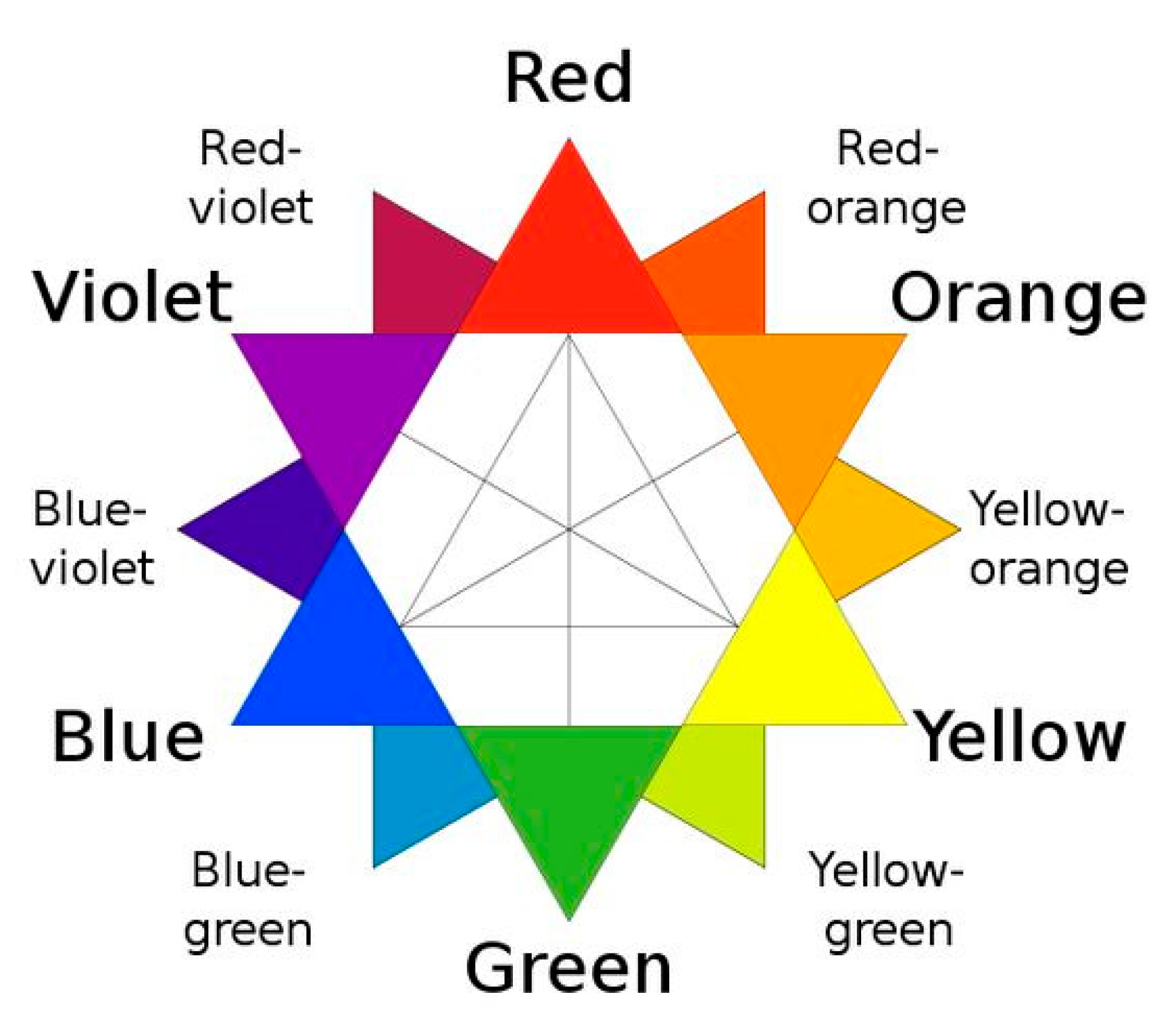

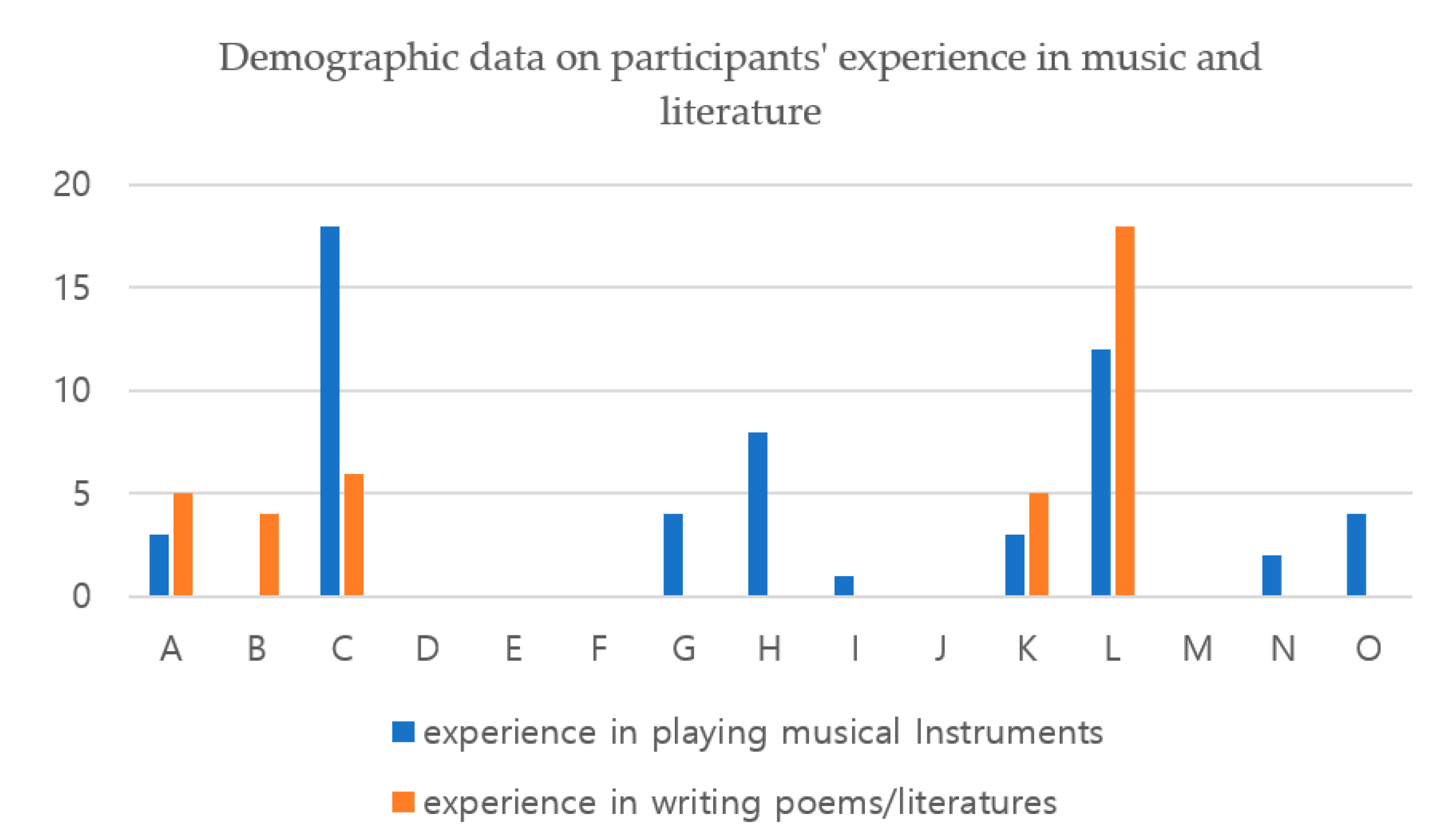
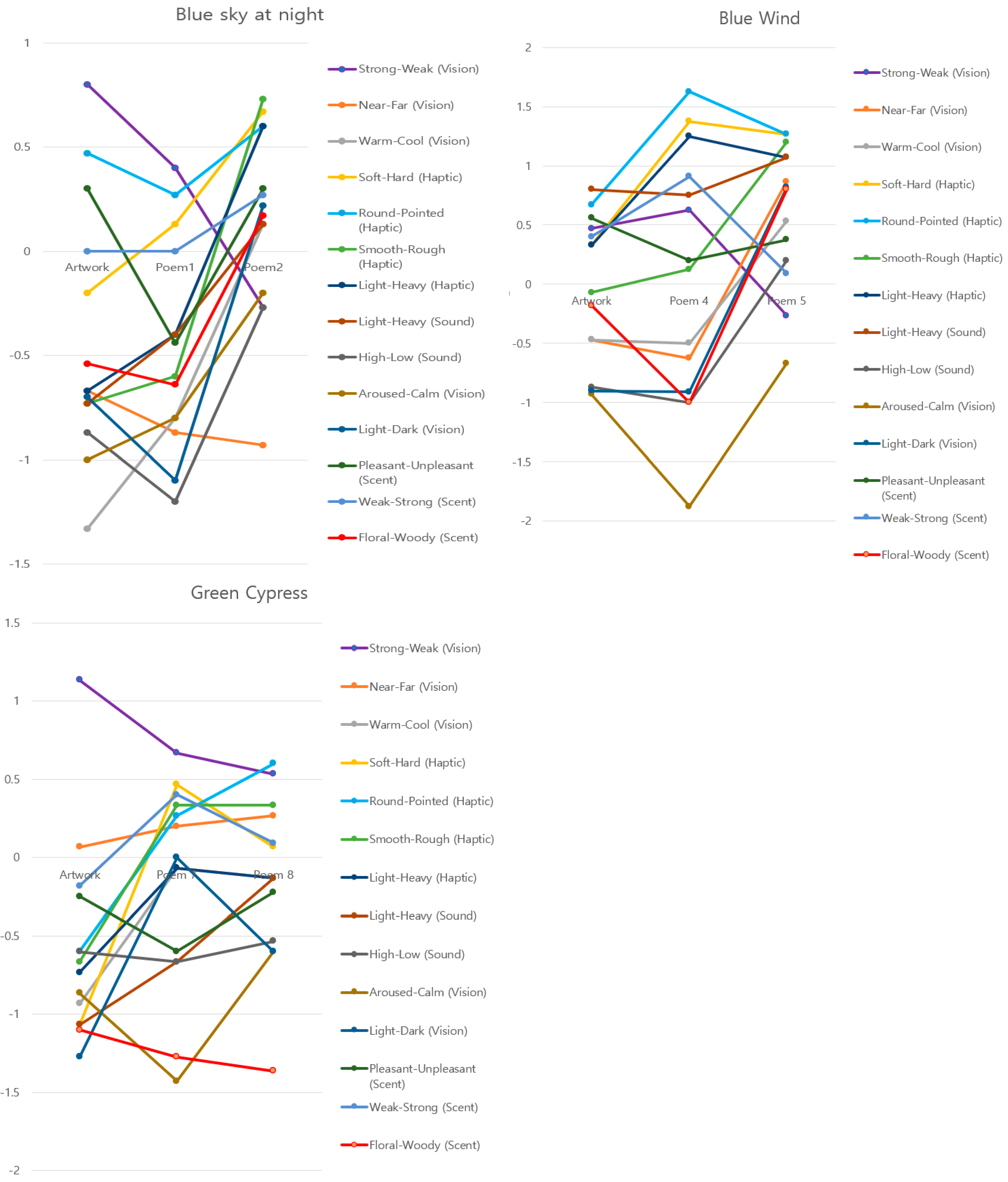
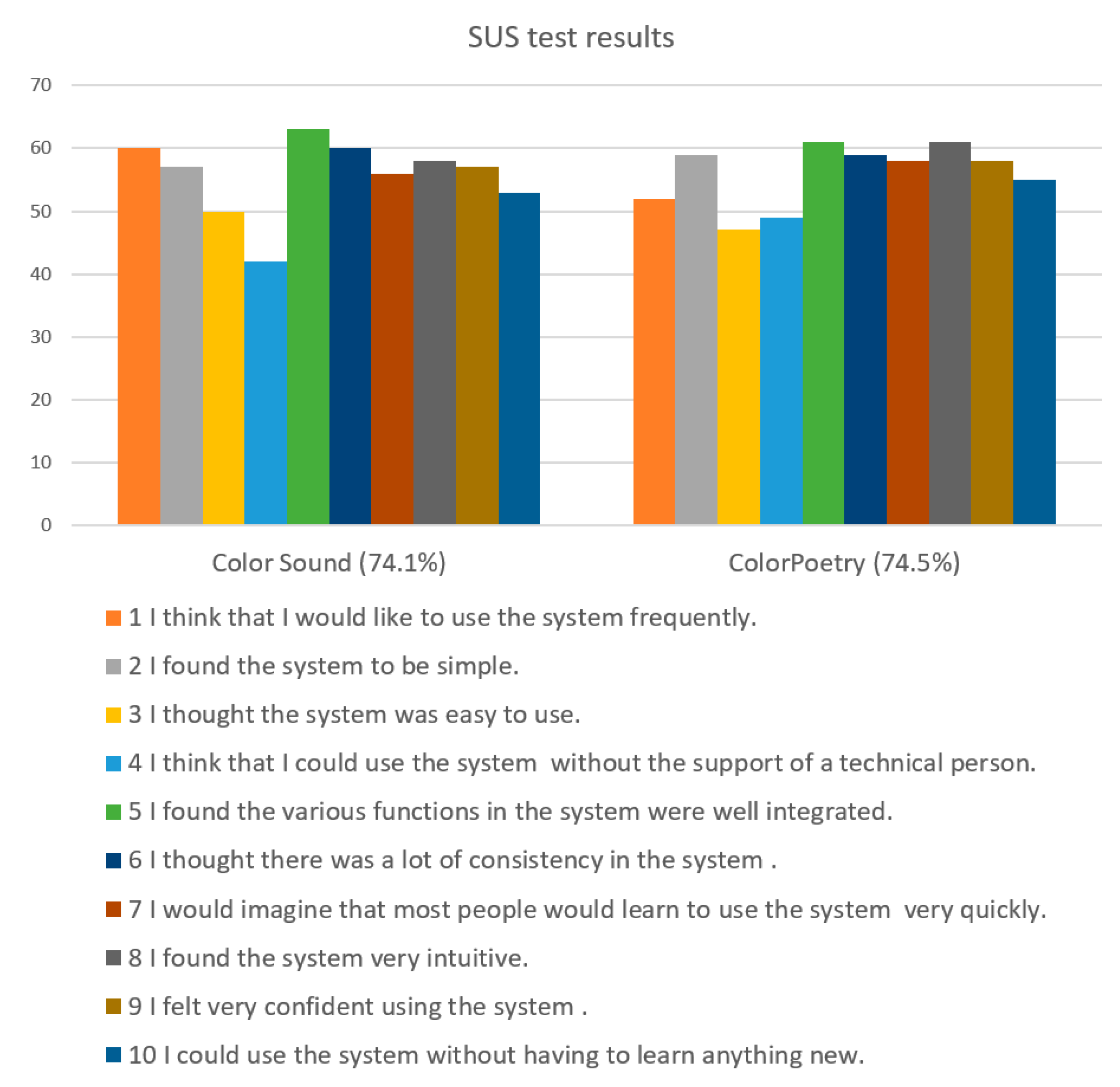
| Instrument and Music | L | V | D |
|---|---|---|---|
| R-Vn. High-frequency banded string instrument Tchaikovsky: Violin Concerto in D |  |  |  |
| O-Va. Medium-frequency banded string instrument Stamitz: Viola Concerto in D |  |  |  |
| Y-Trp. Brass instrument Haydn: Trumpet Concerto in E flat |  |  |  |
| G-Ob. Woodwind instrument with reed Mozart: Oboe Concerto in C |  |  |  |
| B-Vc. Low-frequency banded string instrument Bach: Cello Suite No. 1 in G |  |  |  |
| P-Org. Keyboard instrument with simultaneous expressions Mozart: Eine Kleine Nachtmusik |  |  |  |

| star (Y-L) wind (B-L) tree (G-D) | star (Y-L) wind (B-L) | star (Y-L) wind (B-L) | moon (O-S) | a little dark (Snare drum) |
| star (Y-L) tree (G-D) | star (White) wind (B-L) | wind (B-L) stars (Y-L) | stars (Y-L) trees (G-D) | a little dark (Snare drum) |
| town (G-S) | tree (G-D) | town (G-S) | town (G-S) | dark (Timpani) |
| The Semantic Differential Pair Relevant to Warmness and Coolness (Sensation) | Source |
|---|---|
| Strong~Week (sound) | Jonas et al. [30] |
| Marks et al. [35] | |
| Near~Far (thermal-tactile) | Bartolomé et al. [18] |
| Warm~Cool (vision) | N/A |
| The Semantic Differential Pair Relevant to Lightness and Darkness (Sensation) | Sources |
|---|---|
| Soft~Hard (haptic) | Ludwig and Simner [45] |
| Slobodenyuk et al. [46] | |
| Round (Bouba)~Pointed (Kiki) (haptic) | Ludwig and Simner [45] |
| Smooth~Rough (haptic) | Ludwig and Simner [45] |
| Slobodenyuk et al. [46] | |
| Light~Heavy (haptic) | Slobodenyuk et al. [46] |
| Light~Heavy (sound) | Marks et al. [35] |
| High~low (sound) | Ankins et al. [28] |
| Jonas et al. [30] | |
| Cogan et al. [31] | |
| Kandinsky [32] | |
| Aroused~Calm (vision) | Wilms and Oberfeld [36] |
| Pleasant~unpleasant (scent) | Maric and Jacquot [46] |
| Weak~Strong (scent) | Kemp and Gilbert [49] |
| Floral~Woody (scent) | Fiore [50], Kim [51] |
| Color | Poet | Part of Poem Excerpt from the Original Poem | Modulated Voice | |
|---|---|---|---|---|
| Word | Phrase | |||
| Blue sky | P10: My Imagination of a Purple Sky Premila Patel [62] |
Cool, deep, fathomless a perfect shade of blue the green of Sicilian olives, sunsets orange dazzle, |  |  |
| Cool Dark Green Grass | P11: Green Syed Ali Sagar [63] | Green the optimist and the eye opener Green means clean and hope Glory, Blossom and Life |  |  |
| Warm orange Body | P12: Orange (Color Poem) [64] |
Orange is the sunset its fire, fire is orange also the most vivid color God dared to make. |  |  |
| P13: Orange is Blue Summer Song [65] | The sky is green and the grass is blue the sky is green and the grass is blue blue is orange and orange is blue |  |  | |
| (a) The Semantic Differential Pair Relevant to Warmer of Cooler Color of Each Hue | ||||
| No | The Semantic Differential Pair | S(A) | S(P1) | S(P2) |
| 1 | Strong~Weak (sound) | - | - | - |
| 2 | Near~Far (thermal-tactile) | - | - | - |
| 3 | Warm~Cool (vision) | - | - | - |
| (b) The Semantic Differential Pair Relevant to Lighter/Darker Color of Each Hue | ||||
| 1 | Soft~Hard (haptic) | - | - | - |
| 2 | Round (Bouba)~Pointed (Kiki) (haptic) | - | - | - |
| 3 | Smooth~Rough (haptic) | - | - | - |
| 4 | Light~Heavy (haptic) | - | - | - |
| 5 | Light~Heavy (sound) | - | - | - |
| 6 | High~low (sound) | - | - | - |
| 7 | Aroused~Calm (vision) | - | - | - |
| 8 | Light~Dark (vision) | - | - | - |
| 9 | Pleasant~Unpleasant (scent) | - | - | - |
| 10 | Weak~Strong (scent) | - | - | - |
| 11 | Floral~Woody (scent) | - | - | - |
|
The Starry Night Jun Dong Cho, 2021 |
|---|
 |
| Dark blue sky’s out there, Before daybreak is in; Falling stars here and there, Night and distant moon, Sleepless is my night; [53] |
| A yellow star In a sky Twinkling white ones It’s a yellow bird My beautiful little yellow bird! [55] |
| The wind has a blue tail The wind also has a white tail [56] |
| Crushed orange moon, Hold your color for the delight of night. When you crush orange light for our sight [58] |
| Brown in the color of nature itself. Brown is the color of an oakwood shelf. Brown is the trunks of the trees [59] |
| My favorite colors are green and brown. Green-leafed trees polka-dot our town [61] |
| A | I felt the system’s approach was very creative. I think two systems are easy to use and have a simple interface. |
| B | I think two systems are easy to use and have a simple interface. It does not require special technical knowledge, and I think it will be easy to use regardless of the individual characteristics of the user. |
| D | I think that it is a system that relies on human senses and feelings rather than going through thinking. |
| E | There seems to be no particular difficulty to use the system. I think they are common in everyday life, such as voices, colors, and poetry. |
| - | I think that it is a system that relies on human senses and feelings rather than going through thinking. |
| I don’t need any more knowledge to use the system, but I think that if you have background knowledge about music and poetry provided by the system, it will be of greater help in using the system. | |
| F | It was easier to understand by making the sound different according to the color. |
| L | The system looks very efficient. This system was very good to handle. |
| M | It seemed simple to use because you can hear and feel it right away. |
| At first, it was a little awkward to see how it works, but I think it will be useful afterwards |
| A | It was my first time using it, so I didn’t feel confident about using the system because I was unfamiliar with it. |
| B | In the case of sound color, more diverse interpretations are possible depending on the user regardless of the matching between music and color. Therefore, it helps intuitive understanding that can be relative to each user. However, in the case of poetry, there may be various interpretations of the content for each user, and since the voice matched with poetry excludes such various possibilities, it is judged that it is difficult to feel intuitive from the user’s point of view. |
| C | It seems that you should be able to learn how to use it. |
| E | It will be a little difficult if you don’t understand the proper manual. |
| G | Poetry is okay because it is directly connected to color, but the voice with word is unnatural when savoring poetry. There is no big problem with both when it comes to integration.Poetry seems to be used a lot because the overall system is okay, but music is not. However, in the case of music, people who understand will use it a lot. |
| M | If there is a simple explanation at first, it seems to be easy to use. |
| O | When I first listened without any explanation, it was a little difficult to evaluate or use. |
| Conflicted User Feedbacks | Conflict Resolution (Future Works) |
|---|---|
| D: The sudden change of voice within a single paragraph seems to be unfamiliar yet. F: Having different voices with words could specifically indicate the meaning to be expressed. N: The voice with word units seems to have a more sophisticated feel. O: Applying the same voice to all words in a phrase that contains words related to color is more enjoyable and comfortable than applying a different voice to only words related to color. | These conflicted thoughts between participants can be mediated by using both methods of voice modulation, selectively considering the importance of delivering emotional and cognitive aspects of colors. Also, the voice delivery with modulation may be used limitedly, only for the key color words. |
| B: In the case of music provided in Color Sound, it provides a fairly structured service by varying the pitch and the instruments used, but I think the matching of poetry and color is quite random. G: The connection between musical instruments and colors is completely arbitrary without inevitable reasons. M: There was something I felt while listening to the song, but I don’t think I felt that much about poetry. | Sound will be used for expressing color hues and poetry for expressing various color dimensions like warm, cool, light, dark, etc. |
Publisher’s Note: MDPI stays neutral with regard to jurisdictional claims in published maps and institutional affiliations. |
© 2021 by the authors. Licensee MDPI, Basel, Switzerland. This article is an open access article distributed under the terms and conditions of the Creative Commons Attribution (CC BY) license (https://creativecommons.org/licenses/by/4.0/).
Share and Cite
Cho, J.-D.; Lee, Y. ColorPoetry: Multi-Sensory Experience of Color with Poetry in Visual Arts Appreciation of Persons with Visual Impairment. Electronics 2021, 10, 1064. https://doi.org/10.3390/electronics10091064
Cho J-D, Lee Y. ColorPoetry: Multi-Sensory Experience of Color with Poetry in Visual Arts Appreciation of Persons with Visual Impairment. Electronics. 2021; 10(9):1064. https://doi.org/10.3390/electronics10091064
Chicago/Turabian StyleCho, Jun-Dong, and Yong Lee. 2021. "ColorPoetry: Multi-Sensory Experience of Color with Poetry in Visual Arts Appreciation of Persons with Visual Impairment" Electronics 10, no. 9: 1064. https://doi.org/10.3390/electronics10091064
APA StyleCho, J.-D., & Lee, Y. (2021). ColorPoetry: Multi-Sensory Experience of Color with Poetry in Visual Arts Appreciation of Persons with Visual Impairment. Electronics, 10(9), 1064. https://doi.org/10.3390/electronics10091064







